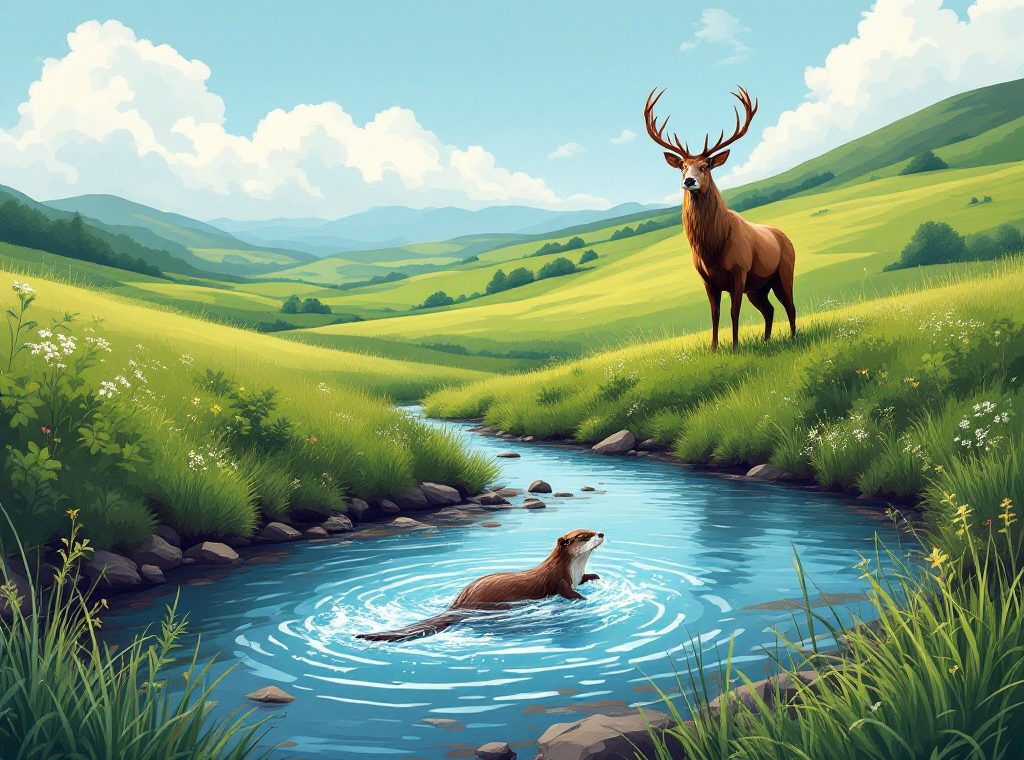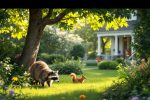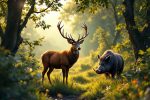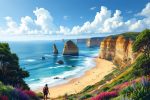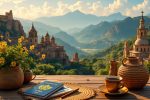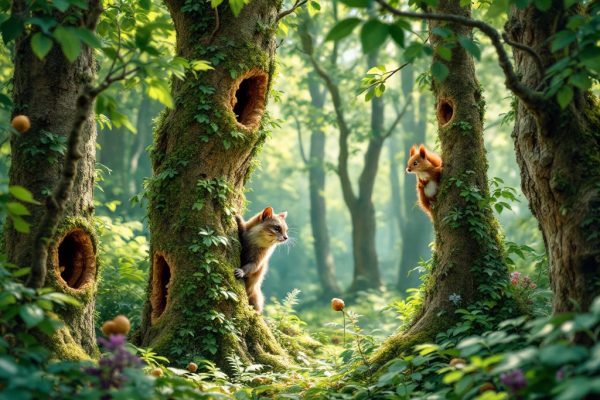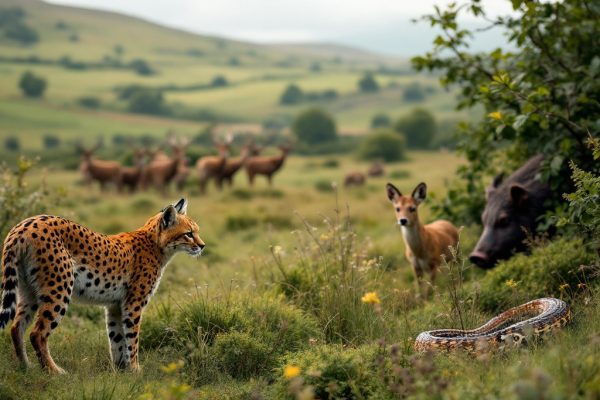How to Draw Wild Animals in Lothian: Guide for Artistic Visitors
Unleash your inner artist amidst the vibrant wildlife of Lothian! From majestic deer in the Pentland Hills to elusive otters along the coast, find inspiration and hone your skills. Discover essential drawing techniques, expert tips from masters like Tim Pond, and recommended resources to capture the spirit of these magnificent creatures. Begin your artistic journey today!
Important information
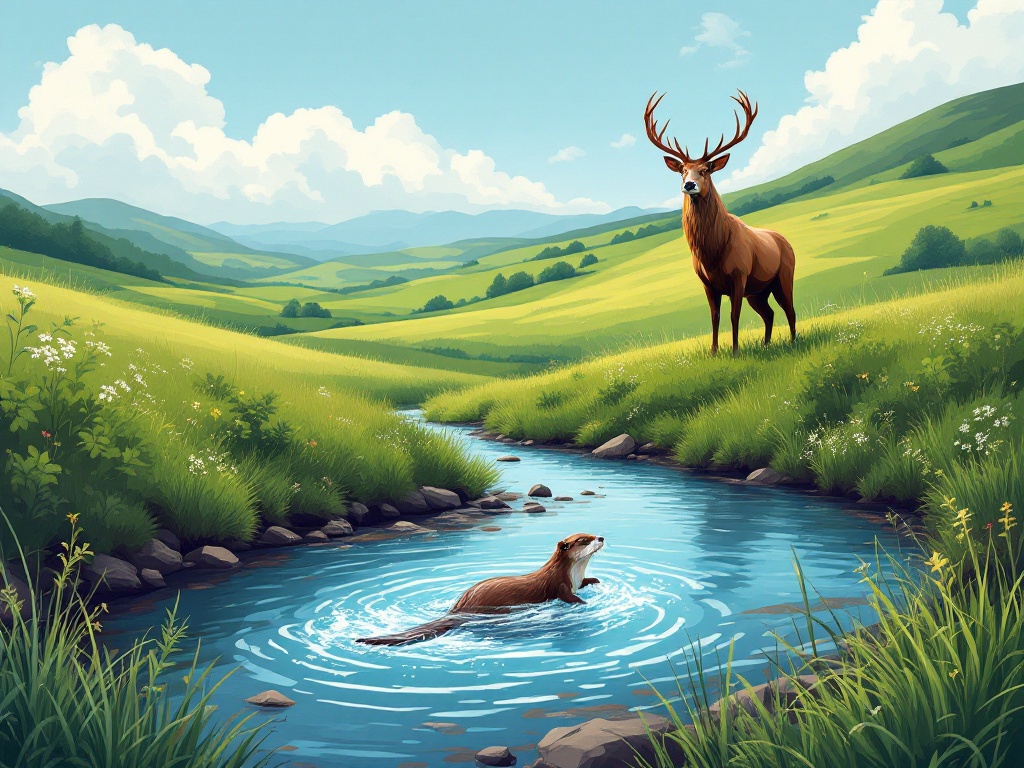
- Lothian, from the Pentland Hills to the coast, offers diverse wildlife viewing opportunities for artists, including deer, foxes, birds of prey, and otters.
- Key drawing techniques include mastering basic shapes, understanding light and shadow, studying animal anatomy, practicing regularly, and learning from established artists.
- Close observation of animal behavior, movement, and features like fur and feathers is crucial for creating lifelike artwork. Quick sketches help capture fleeting moments and poses.
- Recommended resources include books like “The Art of Animal Drawing” and “Animal Anatomy for Artists,” online videos, and field guides. Essential tools include graphite pencils, charcoal, colored pencils or watercolors, a sketchbook, and a portable easel.
- Artists can observe animals both in zoos and in their natural habitats. Zoos offer convenient observation, while wild settings require patience and the use of tools like photographs and binoculars.
Introduction to Drawing Wild Animals in Lothian
Lothian offers incredible opportunities for wildlife artists to sketch diverse creatures. From the rugged Pentland Hills to the scenic East Lothian coast, the region is teeming with wildlife, including deer, foxes, birds of prey, and even elusive otters. Artists can observe these animals in their natural environments, finding inspiration in nature reserves, parks, and tranquil wetlands.
Tips for Beginners
Beginners can start by simplifying animal forms into basic shapes. Numerous resources exist to enhance artistic skills, including:
- local wildlife centers,
- guided tours, and
- online tutorials.
Developing Your Skills
Workshops and classes provide valuable feedback and expert guidance. Experimenting with various mediums can bring artwork to life:
- Charcoal captures the texture of fur,
- Watercolors depict the vibrant plumage of birds.
Drawing Lothian’s wildlife is a rewarding pursuit, connecting artists with nature and fostering creativity.
Essential Drawing Techniques for Artistic Visitors
Master basic shapes. A foundational understanding of shapes is essential for any drawing.
Understand perspective, light, and shadow. These principles are key to creating realistic and three-dimensional drawings.
Study animal anatomy. For wildlife artists, understanding skeletal and muscular structures is crucial for depicting realistic poses and proportions.
Practice regularly. Quick sketches and experimentation with various media are vital for improvement and can effectively capture animal movement and posture.
Study established artists. Observing the works of masters and focusing on the interplay of light and shadow will add depth and realism to your drawings.
Understanding Basic Shapes and Animal Anatomy
Start with basic shapes like circles, squares, and triangles to establish accurate proportions.
Then, explore the underlying skeletal and muscular structures.
This anatomical understanding is crucial for portraying realistic poses and dynamic movement, ultimately transforming your wildlife art into believable, lifelike creatures.
Exploring Different Drawing Methods and Media
Pencils offer remarkable control, ideal for precise and detailed artwork.
Charcoal excels at creating expressive lines and dramatic shading.
Digital tools like tablets and styluses provide flexibility and effortless editing, along with the ability to experiment with various paper textures, ultimately influencing the final artwork.
Step-by-Step Lessons for Beginners
Start with simple shapes to build your animal, gradually adding details. This method helps beginners understand proportions and gain confidence. Although a warthog may seem difficult to draw, this approach simplifies the process, making it more manageable.
Wildlife Illustration: Capturing the Spirit of Animals
Capturing realistic animal poses requires close observation. Watch their behavior and interactions with the environment, using quick sketches to capture fleeting moments.Movement is essential for bringing animal art to life. Focus on the animal’s gesture and the flow of its body, emphasizing lines of action and rhythmic movement to convey its energy and spirit.Fur and feathers add texture and realism. Varying line weights and techniques like stippling or hatching create depth, while observing fur or feather growth direction enhances realism.
Observation Skills and Animal Poses
To capture realistic animal poses, keen observation is essential. Artists refine their skills through anatomical studies and understanding proportions. Quick sketches are invaluable for capturing fleeting movements. Observing live animals and using photographs both enhance accuracy. Light and shadow add depth and dimension. Regular practice is key to improvement, but observation remains paramount. Notice how an animal’s weight shifts; this informs your drawing. Furthermore, a grasp of musculature enhances the realism of your poses.
Keen observation is essential for capturing realistic animal poses.
Study animal anatomy and understand proportions to refine your skills.
Use quick sketches to capture fleeting movements.
Observe live animals and use photographs to enhance accuracy.
Use light and shadow to add depth and dimension.
Notice how an animal’s weight shifts to inform your drawing.
Understand musculature to enhance the realism of your poses.
Movement and the Spirit of the Animal
Quick gesture sketches are an artist’s tool for capturing the fleeting movements of animals. These sketches focus on pose and limb placement, helping artists predict an animal’s next action by observing its behavior. This understanding of motion translates into dynamic drawings that convey the animal’s spirit and enrich the artwork. For instance, a sketch of a leaping cat can express its energy and agility, while a drawing of a resting dog might convey calmness and contentment. These simple, yet powerful sketches bring animals to life on the page.
Fur and Feathers: Detailed Features
Bringing animal drawings to life means capturing the realistic textures of fur and feathers. Observe how these elements lie on the body, noting the direction and structure. Feathers range from the softest down to the rigid structure of flight feathers. Fur also exhibits a wide variety of lengths, densities, and patterns, unique to each animal. Close observation is crucial for capturing these nuances. Artists use layered pencil strokes and eraser techniques to create the illusion of depth and texture, ultimately showcasing the distinctive qualities of fur and feathers.
Drawing a Variety of Animal Species
Animals display a fascinating variety of diets. Carnivores, such as lions and wolves, possess sharp teeth designed for tearing meat. Herbivores, like deer and rabbits, use flat teeth to grind plants. Omnivores, including bears and raccoons, have adapted teeth suited to consuming both plants and meat.
Big cats, encompassing lions, tigers, and leopards, are agile predators.
Massive elephants are distinguished by their tusks and trunks.
Giraffes are instantly recognizable due to their remarkably long necks and distinctive spotted coats.
Captivity significantly alters animal behavior. Zoo animals, living in controlled environments and interacting with humans, often become reliant on people for food. Consequently, they may not develop crucial survival skills.
Wild animals in their natural habitats must hunt, forage, and evade predators to survive.
Carnivores, Herbivores, and Omnivores
Carnivores, such as lions, tigers, and wolves, primarily eat meat. Their sharp teeth are designed for tearing flesh, and their digestive systems efficiently process protein.
- lions,
- tigers,
- wolves.
Herbivores, including deer, rabbits, and cows, thrive on plants. Their teeth grind vegetation, and their digestive systems break down cellulose.
- deer,
- rabbits,
- cows.
Omnivores, like bears, raccoons, and pigs, consume both plants and meat. Their digestive systems handle both food types.
- bears,
- raccoons,
- pigs.
Understanding dietary differences is crucial for artists. When depicting a carnivore, an artist might emphasize predatory stances and sharp teeth. Herbivores are often shown grazing, their flatter teeth clearly visible. Omnivores may exhibit characteristics of both, reflecting their diverse diet.
Big Cats, Elephants, and Giraffes
Drawing majestic creatures presents unique artistic challenges and rewards. Capturing the dynamic poses and intricate fur patterns of big cats like lions, tigers, and leopards is a thrilling endeavor. Rendering the sheer size, wrinkled skin, and volume of elephants presents a different, but equally rewarding, challenge. Meanwhile, accurately portraying the towering height, unique spots, and elegant proportions of giraffes demands careful observation and artistic skill. Through drawing these magnificent animals, artists develop a deeper understanding of animal anatomy, hone their skills in capturing movement and rendering textures, and gain a profound appreciation for the diversity and beauty of the animal kingdom.
Zoo Animals vs. Wild Breeds
Zoo animals, living in controlled environments, offer artists an unparalleled opportunity for close observation and detailed behavioral studies. Artists can closely observe these animals, allowing for detailed studies of their behavior and unique traits.
Wild animals, residing in their natural habitats, present a different challenge. Their elusive nature makes close study difficult, so artists often rely on photographs or brief observations to capture their essence and the intricacies of their environment. Illustrations of wild animals typically focus on a specific interaction between the creature and its habitat.
Outdoor Drawing in Lothian: Embracing Nature
Field guides are invaluable resources for wildlife artists, offering helpful diagrams and tips for accurately portraying animals. Nature illustration beautifully marries scientific observation with artistic expression, demanding careful observation to create lifelike drawings. Capturing details like fur texture, feather patterns, and the interplay of light and shadow is essential.
Lothian presents a rich tapestry of wildlife subjects, from birds of prey soaring above the Pentland Hills to seals basking along the scenic coastline. This diverse fauna provides endless inspiration, allowing artists to capture the region’s natural beauty and reflect its varied landscapes in their work.
The rugged hills and tranquil coastline offer unique artistic opportunities, further enriched by the region’s diverse flora. Mastering wildlife drawing, however, requires both practice and patience.
Field Guide to Drawing Wildlife
A field guide is invaluable for any artist venturing into wildlife drawing. It provides insightful techniques and expert advice for portraying animals in their natural habitats. Here’s what you need to bring:
- A sketchbook, pencils ranging in hardness, and your preferred coloring tools (colored pencils or watercolors).
- A portable easel and reference photos (optional but helpful).
On location, patience and observation become your most important tools. Quick sketches are ideal for capturing fleeting movements, while longer sessions permit detailed studies. Always respect the animals’ space.To elevate your wildlife art:
- Hone your observation skills.
- Study animal anatomy.
- Practice gesture drawing.
- Experiment with different styles like contour drawing or adding textures to depict fur and feathers, breathing life into your animal portraits.
Nature Illustration and Lifelike Drawings
Nature illustration beautifully captures animals in their natural habitats, blending art and science. Artists create detailed, lifelike portrayals of wildlife, preserving each animal’s essence. They use tools like graphite, charcoal, and watercolors to bring textures to life. Field sketching and binoculars are essential tools for these artists. They allow them to observe animal behavior and poses, and understand anatomy. By incorporating environmental details, the illustrations become authentic windows into the wild.
Expert Illustrations and Accessible Guidance
Ready to elevate your animal drawings? Learn from masters like Tim Pond and J.C. Amberlyn. These experts blend scientific observation with artistic skill, creating incredibly lifelike animal portraits. Their accessible advice benefits both beginners and experienced artists, offering valuable techniques to enhance your wildlife art. Start improving your skills today with these easy-to-use resources.
Insights from Tim Pond, J.C. Amberlyn, and Others
Tim Pond’s wildlife illustrations begin with meticulous anatomical studies, reflecting a deep understanding of animal structure.
J.C. Amberlyn prioritizes the essence of animal behavior, using quick sketches and expressive lines to convey movement and vitality.
Other wildlife artists emphasize habitat, believing that portraying the ecosystem adds crucial depth and context, enriching the final artwork.
Combining Science and Art for Realistic Drawings
A deep understanding of animal anatomy and movement is essential for artists seeking realism. This scientific foundation allows them to accurately depict animal forms and motion, blending observation with artistic skill to capture the essence and behavior of their subjects, ultimately bringing their creations to life. A solid grasp of anatomical structures, such as bones, muscles, and tendons, enables artists to create believable representations of animals in various poses and actions. By studying how these structures interact during movement, artists gain insights into the subtle nuances of animal locomotion, breathing, and other bodily functions. This knowledge empowers them to portray animals with greater accuracy and dynamism, conveying a sense of weight, balance, and fluidity in their artwork. Furthermore, understanding the underlying principles of animal anatomy informs artistic choices regarding proportions, posture, and gesture. By observing how different species move and behave, artists can capture the unique characteristics that define each animal. This combination of scientific understanding and artistic skill allows artists to create truly lifelike representations of animals, enriching their work with authenticity and emotional depth.
Recommended Resources and Art Materials
Want to draw animals? Here’s how to get started.
Resources
- Books: Ken Hultgren’s “The Art of Animal Drawing” offers valuable insights, while Eliot Goldfinger’s “Animal Anatomy for Artists” provides a detailed anatomical approach.
- Videos: “Drawing Wildlife with Jonathan Yeo” offers expert guidance for visual learners.
Tools
- Graphite pencils: Varying hardnesses are essential for achieving different effects.
- Charcoal: Adds depth and texture.
- Colored pencils or watercolors: For adding color.
- Sketchbook: A quality sketchbook is a must.
- Portable easel: Handy for drawing outdoors.
- Erasers and blending tools: To refine your work.
Books and Videos for Learning and Inspiration
Ready to sketch stunning wildlife? Explore these exceptional resources:
- Guides: “How to Draw: Wild Animals” and “The Wildlife Artist’s Handbook” offer in-depth instruction.
- Online Platforms: YouTube and Skillshare provide inspiring video tutorials packed with practical advice.
Grab your pencils and start creating!
Essential Tools for the Drawing Process
Essential art supplies for aspiring artists include a sketchbook, pencils (ranging in hardness from H to B), erasers, and a sharpener. For smooth and refined shading, consider using blending tools like stumps or tortillons.
Explore vibrant color options with watercolor sets, colored pencils, or pastels. A portable easel is invaluable for outdoor painting sessions. Protect your supplies from unpredictable weather with a waterproof bag. Enhance accuracy and capture the beauty around you using reference images or a field guide.

